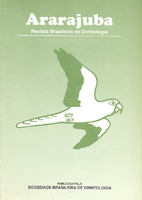
Age and gender related plumage variation of psittacofulvine pigments: the case of the Yellow-faced Parrot Alipiopsitta xanthops
Abstract
The Yellow-faced Parrot Alipiopsitta xanthops presents considerable phenotypic variation with a belly coloration that may vary from green to yellow-red. Though it has been hypothesized that this variation could be related to sex or age, these possibilities remain untested. We therefore tested these hypotheses by verifying geographical, sexual, and age-related trends in coloration based on museum specimens, wild populations, and captive developing juvenile birds. We found colored belly parrots (CBP) throughout the species distribution of A. xanthops. We found no differences in the proportion of CBP individuals between the two wild populations sampled (overall mean of 8.7%), but the proportion of CBP in museums was higher (32%) indicating that specimens were probably not randomly collected. We also found a skewed sex ratio in museums, as females represented only 25% of the specimens. We found that 37% of museum males had colored bellies, in contrast with only 18% of females; furthermore, colored bellied males presented a greater area of yellow-red patch on their bodies. None of the 16 observed fledglings presented colored bellies. The yellow head coloration slowly grew over the 14 days of observation of 16 nestlings. Together, our results suggest that color variation in the Yellow- faced Parrot seems to be related to both age and gender.
Full Text:
PDF** The work of the Editor in Chief, Managing Office, Associate Editors, and the Editorial Council of Revista Brasileira de Ornitologia is strictly voluntary, and does not involve the use of any resources and infrastructure other than the personal ones**



